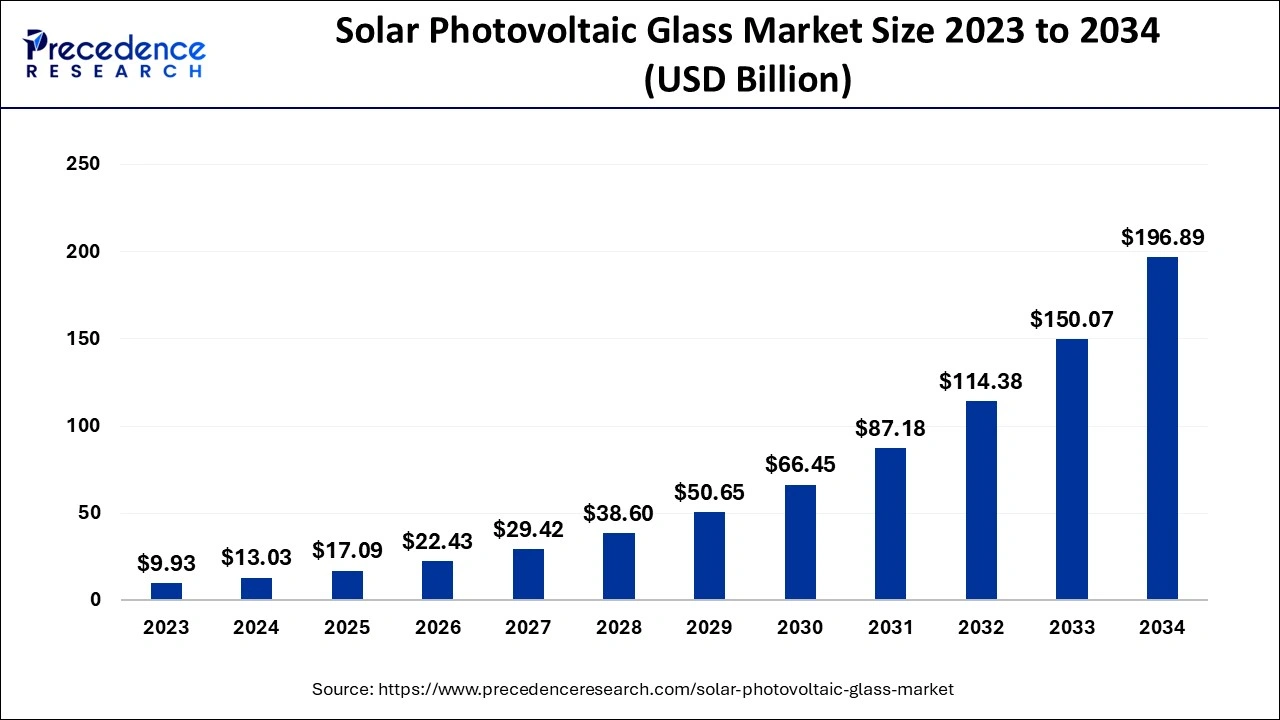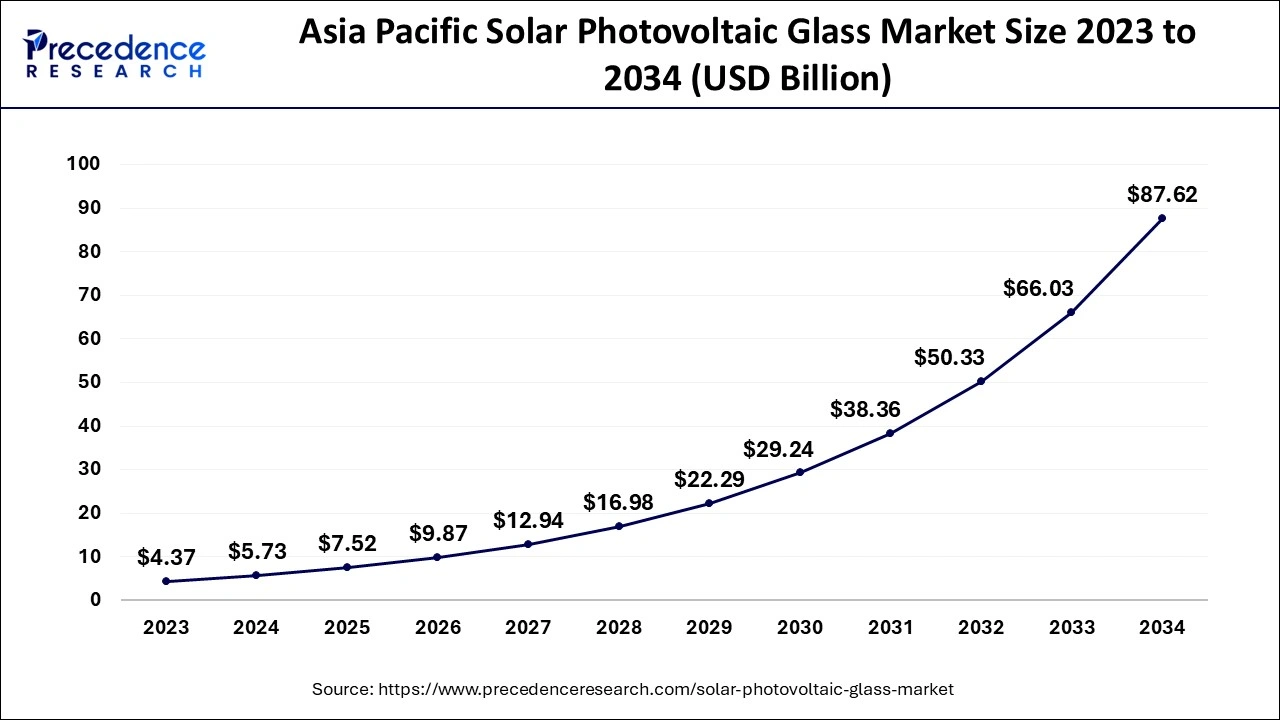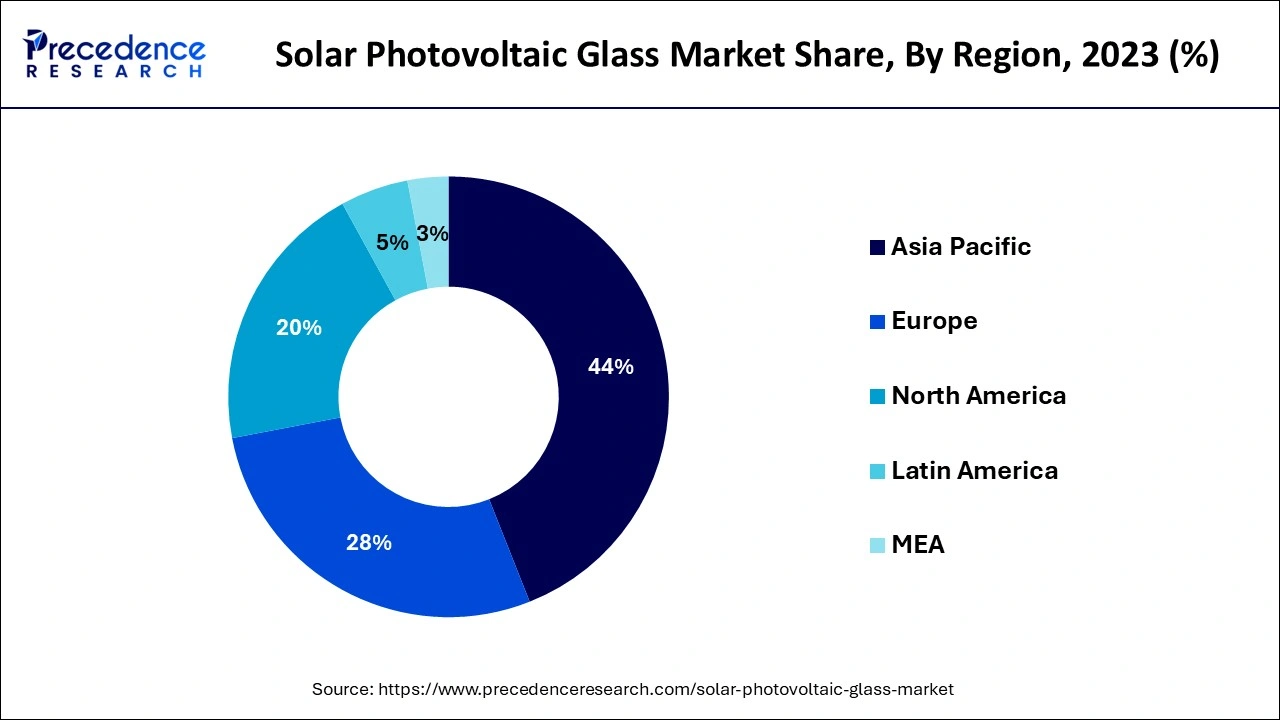List of Contents
What is the Solar Photovoltaic Glass Market Size?
The global solar photovoltaic glass market size is valued at USD 17.09 billion in 2025 and is predicted to increase from USD 22.43 billion in 2026 to approximately USD 196.89 billion by 2034, expanding at a CAGR of 31.20% from 2025 to 2034.

Solar Photovoltaic Glass Market Key Takeaways
- Asia Pacific dominated solar photovoltaic glass market in 2024.
- By end user, the building and construction segment led the market in 2024.
What is a Solar Photovoltaic Glass?
Transparent semiconductor-based photovoltaic cells, often known as solar cells, are used in solar photovoltaic (PV) glass, a technology that makes it possible to convert sunlight into energy. These thin film or crystalline silicon solar cells, which are sandwiched between two panes of glass, are utilized for PV applications. While thin film solar cells employ very transparent float glass as its cover, crystalline silicon solar cells use ultra-clear figured glass. The power produced by the solar PV cells guarantees energy cost reductions while lowering carbon footprints and greenhouse gas emissions.
Additionally, the growing preference for renewable energy sources as a result of growing environmental concerns is anticipated to support the growth of the solar PV glass market throughout the course of the projected period. During the forecast period, favourable government regulations such as the Kyoto Protocol Act, which promotes the use of solar PV panels by lowering carbon emissions, are also anticipated to drive the market for solar PV glass. Buildings and rooftop systems may readily include solar PV glass, resulting in the production of renewable energy through the efficient utilization of solar energy and innovative architectural design.
Additionally, it is estimated that the market for solar PV glass would expand over the course of the projected period due to consumers' increasing preference for renewable energy sources as a consequence of growing environmental concerns. Favourable government laws like the Kyoto Protocol Act, which encourages the use of solar PV panels by reducing carbon emissions, are also expected to propel the market for solar PV glass throughout the projected period. Solar PV glass is easily incorporated into buildings and rooftop systems, enabling the generation of renewable energy through the effective use of solar energy and creative architectural design.
Market Outlook
- Industry Growth Overview:
The solar photovoltaic glass market is growing, driven by growing renewable energy demand, helpful regulatory policies, and technological development. Its significant role in solar panels, its use in building-combined photovoltaics (BIPV), and regulatory incentives to increase solar capacity and domestic manufacturing. - Global Expansion:
The solar photovoltaic glass market is increasing worldwide, driven by demand for renewable energy, sustainable construction, and government regulations. Sustainability trends and the demand for energy-driven buildings are driving the incorporation of solar glass in construction. Asia Pacific is dominated in the market by strong government investment, through strategies and incentives like China's spending guidelines. - Major investors:
Major investors in the solar photovoltaic glass industry include large manufacturers like Xinyi Solar, Flat Glass Group, AGC Inc., and Nippon Sheet Glass.
Solar Photovoltaic Glass Market Growth Factors
The market for solar PV glass is expanding as a result of rising PV installations and supportive government policies. The utilities sector is anticipated to present significant potential for solar PV glass over the forecast period because to the rising power needs and relatively cheaper costs associated with solar PV installations compared to traditional energy sources. The market for solar PV glass is also anticipated to grow during the projected period due to expanding awareness of the advantages of renewable energy sources and the pressing need to reduce emissions.
During the projection period, more PV installations in the residential sector are anticipated due to rising disposable incomes. This would significantly increase the demand for solar PV glass throughout the anticipated period.
Market Scope
| Report Coverage | Details |
| Market Size in 2025 | USD 17.09 Billion |
| Market Size in 2026 | USD 22.43 Billion |
| Market Size by 2034 | USD 196.89 Billion |
| Growth Rate from 2025 to 2034 | CAGR of 31.20% |
| Base Year | 2024 |
| Forecast Period | 2025 to 2034 |
| Segments Covered | Type, Grade of Transparency, Application, End Use, and Geography |
| Regions Covered | North America, Europe, Asia-Pacific, Latin America, and Middle East & Africa |
Market Dynamics
Key Market Drivers
- Solar Photovoltaic Glasses Having high performance - Building envelopes that enable decreasing the energy demand is crucial for meeting the aims of green building requirements, which is the current problem facing the construction industry. Facades manage the building's HVAC requirements, which eventually helps to use less electricity than before.
- Facade upgrading enhances the performance of aging buildings - A large portion of the current stock of tall buildings is plagued by aging and underperformance. When facades are retrofitted, buildings function significantly better, which will increase the market for facades. Retrofitting facades is also probably more cost- and environmentally-friendly than demolishing and rebuilding facades.
- Rapid infrastructural development and industrialization will boost the market for solar photovoltaic glass - The development of solar photovoltaic glass is being driven by the global industrialization boom, improvement in the economic climate, and increase in infrastructure construction. According to Oxford Economics, between 2016 and 2040, the world needs to invest $94 trillion on infrastructure. This is 19% more than what would be provided if present trends continued. With the expansion of infrastructure and industrialization, which is boosting the market for solar photovoltaic glass.
Key Market Challenges
Hotspots on the panels can restrict the solar photovoltaic glass market
The hot spots are areas of the plates that are overworked and get moist. Hotspots on panels are typically the consequence of poorly lost connections or a structural flaw in solar cells. Low resistance is caused by bad solder joints in the area of the panel that receives the electricity generated by the cell. This occurrence will ultimately result in a short circuit, which will lower the PV panel's efficiency and longevity. We have discovered hot spots in certain solar parks, necessitating the replacement of solar panels and significantly raising the projects' Opex expenses.
Key Market Opportunities
Renewable Energy and Green Building Construction Technology is restraining the growth of the solar photovoltaic glass market
Additionally, governments in several nations have worked to promote the use of renewable energy sources in order to provide lucrative chances to market participants throughout the projected period of 2023 to 2032. The development of green building construction methods, which increasingly use solar photovoltaic glasses as a component of sustainable construction, also contributes to the market's future growth.
Development of off-grid electricity systems
It offers producers in the solar photovoltaic glass market sector enormous expansion prospects. Off-grid technology is viewed as the most practical way to fixing power concerns in deep pockets across important developing countries in the globe, where more than a billion people live without access to electricity. This includes offering fundamental heating and lighting services to some of the most isolated regions of the globe where grid connections are impractical. Off-grid electricity systems are commonly powered by solar energy, and nations like China and a few others in the South East Asia Pacific region have taken use of the potential of small-scale solar technology applications to bring electricity to residents in isolated rural locations.
Segment Insights
Type Insights
In 2024, the solar photovoltaic glass market's highest market share belonged to photovoltaic glass. Solar photovoltaic (PV) glass is a type of glass that uses solar cells to convert solar energy into electricity. This is installed inside a building's roof or façade area to generate electricity for the entire home. These glasses feature a special resin filler, and between the two glass panes are solar cells. The solar cells are securely bound by these polymers on all sides. A frame that is linked to other cells is created by joining each cell to two electrical connections.
Other reasons boosting the market for Solar PV glass include government assistance for the development of Solar PV facilities. In addition, the market for solar PV glass is expanding due to the rising demand for home, business, and utility-scale solar systems. Solar photovoltaic glass is still not in high enough demand on a worldwide scale. Opportunities for market expansion are anticipated to result from the increased demand for renewable energy.
Grade of Transparency Insights
In 2024, the Solar photovoltaic glass market's highest share belonged to high transparency. 61% of the sunlight they get is absorbed by high transparency solar photovoltaic glass. Performance of these glass panels is 7.2% as opposed to standard solar photovoltaic panels' performance of 12.2%. Because the panel only absorbs 60% of the light and transmits the other 40% via the screen, the output is reduced. Invisible wavelengths of sunlight are absorbed by organic molecules in transparent windows to produce solar panels. These clear solar windows have a lot of promise.
In the US alone, there are up to 7 billion square meters of glass surfaces. Surface space that has to be transparent might be used by these materials integrated in windows. In fact, if the transparency of the material can be adjusted, they may also be utilized as illumination to keep people inside buildings cooler, helping to save the costs associated with air conditioning.
Application Insights
In the Solar photovoltaic glass market, Facades is anticipated to have the largest share in 2024. Because they reduce the cost of cement or adhesive purchases and are energy efficient, facade panels are also economical. Due to the increasing increase in the building of residential, commercial, and industrial structures worldwide, the global facades industry is expanding rapidly. The need for such energy-efficient materials has expanded as a result of the technological developments in the building and infrastructure sectors. Over the past five years, the commercial building sector has experienced phenomenal growth.
The expansion of infrastructure investment continues to fuel the building and construction industries, which in turn fuels the need for facades. Due to the many advantages the facade system offers, including acoustic insulation, thermal insulation, and natural ventilation, the commercial application was the area with the highest demand for facades. The commercial sector continued to develop throughout 2019, but recently it has slowed as the possibility of a slowdown in global construction rises as a result of the COVID-19 pandemic, which temporarily shut down all economic activity throughout the world.
End Use Insights
The solar photovoltaic glass market is dominated by building and construction, which hold 32% market share. The need for solar photovoltaic glass for all types of buildings is anticipated to increase due to the expanding construction sector and its demand, notably in the areas of Asia-Pacific, North America, and Europe. Due to increased penetration from undeveloped markets, the residential application category is growing. In this application industry, first-mover advantage in unexplored regions and relatively cheap acquisition costs continue to be important driving drivers.
Additionally, R&D in solar photovoltaic glass will aid in the market's expansion. The ability for windows to produce energy is going to enter the architectural glazing industry. Solar cells built into glass window panels will make it possible to use the sun's energy to insulate buildings from the cold while controlling the interior light levels. In a similar vein, Tesla has shown its residential solar roof tile. The market for solar photovoltaic glass will grow as a result of technological advancements.
Regional Insights
Asia Pacific Solar Photovoltaic Glass Market Size and Growth 2025 to 2034
The Asia Pacific solar photovoltaic glass market size is evaluated at USD 7.52 billion in 2025 and is predicted to be worth around USD 87.62 billion by 2034, rising at a CAGR of 31.35% from 2025 to 2034.

Growth In Building Construction Fuels APAC Solar Glass Market
The solar photovoltaic glass market was headed by Asia-Pacific (APAC), which saw a share of around 44%, followed by North America and Europe. The building sector in APAC will likely remain one of the biggest and fastest-growing in the world. In the upcoming years, it is anticipated that large and established markets like China, India, Japan, and South Korea would expand more. China, followed by India and Japan, is the country driving the majority of the demand for solar photovoltaic glass in the Asia-Pacific area. All of the Asian nations, including China and India, which are important drivers of the demand for construction investment in these regions, make up the five fastest-growing construction regions outside of the United States. The increasing middle class and expanding population are factors that tend to fuel the development of the APAC residential building industry and, by extension, the solar photovoltaic glass market.
In the APAC area, the number of buildings using lighted solar photovoltaic glass is rapidly increasing. The market has been further boosted by the surge in rehabilitation projects and the number of new building builds. Currently, the COVID-19 epidemic has had an impact on the construction sector since the majority of industrial activity has been temporarily halted. In turn, this has had an impact on the demand and supply chain, which has been limiting growth in 2021.

North America: High demand for solar energy
North America is the fastest-growing market in the forecast period, as modern solar energy adoption, helpful government guidelines such as the Inflation Reduction Act, and an increasing demand for building-integrated photovoltaics (BIPV). The increasing integration of solar glass into building materials for both new construction and retrofits contributes to the growth of the market.
U.S.: Increasing government incentives and policies
In the U.S., increasing push toward sustainability and the requirement to meet climate targets are increasing demand for solar energy, which in turn fuels the requirement for PV glass. The U.S. government has maintained the solar sector through programs such as the Investment Tax Credit (ITC), which provides a noteworthy tax credit for solar installations, driving the growth of the market.
Europe: Technological advancements and innovation
Europe is experiencing substantial growth in the market, driven by government initiatives like the EU Emissions Trading System (EU ETS) and national objectives, such as Germany's carbon reduction targets and the UK's plan to phase out fossil fuel plants. The region is emphasizing diversification of energy sources to lessen reliance on fossil fuels, with solar energy becoming vital for energy security, thereby fueling market expansion.
UK: Technological advancements
The UK government has released guidelines to encourage renewable energy, like supporting rooftop solar installations and enacting rules to curb carbon emissions. Novel in solar PV glass technologies, like anti-reflective coatings, are rowing panel efficiency, which drives the growth of the market.
Solar Photovoltaic Glass Market- Value Chain Analysis
Raw Material Sourcing:
Raw material sourcing for solar photovoltaic (PV) glass involves acquiring high-purity supplies like soda ash, silica sand, and limestone to make specialized glass for solar panels.
- Key Players: Adani Solar and Dongguan Csg Solar
Package Design and Prototyping:
Package design and prototyping for solar photovoltaic (PV) glass includes creating particular, protective, and often custom services for the harmless transport, handling, and incorporation of the fragile glass components that make up solar panels.
- Key Players:Saint-Gobain and Xinyi Solar
Recycling and Waste Management:
Recycling and waste management for solar photovoltaic (PV) glass contributes to a many-step process to separate and recover materials such as aluminum, glass, and silicon from end-of-life panels.
- Key Players: Borosil Renewables and AGC Inc.
Top Vendors in the Solar Photovoltaic Glass Market & Their Offerings
|
Company |
Headquarters |
Key Strengths |
Latest Info (2025) |
|
AGC Glass Europe |
Belgium |
Operational excellence |
In October 2025, AGC Glass Europe and SOLAR MATERIALS announced a strategic partnership to advance PV flat glass circularity. |
|
Nippon Sheet Glass Co., Ltd. |
Japan |
Incorporation of plastomer. |
In January 2025, NSG Group is pleased to announce the warm-up of a newly converted TCO (transparent conductive oxide) facility in the United States. |
|
Taiwan Glass Industry Corporation |
Taiwan |
Integrated production process |
Taiwan Glass Industry Corporation manufactures glass products. The Company's products include float glass, glass fibers, and fabrics. |
|
Xinyi Solar Holdings Limited |
China |
Vertically integrated business model |
Xinyi Solar Holdings Limited is one of the world's leading photovoltaic glass manufacturers and specialises in research and development, manufacturing, and sales. |
|
Sisecam |
Turkey |
Highly diversified industrial base. |
In September 2025, Sisecam commissioned novel energy glass lines in Tarsus. With an investment of €200 million, the company's goal is to meet the increasing demand for glass in the solar energy industry and enhance export potential. |
Other Major Key Players
- Guardian Glass (Thailand)
- Saint-Gobain (France)
- Borosil Limited (India)
- China-Henan Huamei Chemical Co., Ltd., (China)
- Interfloat Corporation (Germany)
- Guangdong Golden Glass Technologies Ltd., (China)
- Hecker Glastechnik GmbH & Co. KG (Germany)
- ENF Ltd., (Germany)
- Emmvee Toughened Glass Private Limited (India)
- Euroglas GmbH (Germany)
Recent Developments
- FuturaSun introduced a monocrystalline PERC panel in February 2020 with a 60-cell dual-glass construction and 320-330 W of power output. Two connected 2 mm tempered glass sheets are touted to provide optimal mechanical stability, outstanding resistance, and durability, giving the Duetto module considerable resistance against bad weather.
Segments covered in the report
By Type
- Photovoltaic Glass
- Multifunctional Glass
- AR Coated
- Tempered
- Others
By Grade of Transparency
- Low Transparency
- Medium Transparency
- High Transparency
By Application
- Curtain Walls
- Facades
- Skylights
- Solar PV Panels
- Glazing
- Wind Shield
- Others
By End Use
- Building and Construction
- Automotive Industry
- Solar Energy
- Infrastructure
- Others
By Geography
- North America
- Europe
- Asia-Pacific
- Latin America
- Middle East & Africa (MEA)
For inquiries regarding discounts, bulk purchases, or customization requests, please contact us at sales@precedenceresearch.com
Frequently Asked Questions
Ask For Sample
No cookie-cutter, only authentic analysis – take the 1st step to become a Precedence Research client



